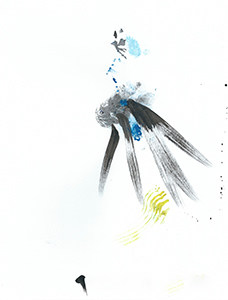By Sandra Dee Owens
I bought another half gallon of eggnog—my fourth of the season. Dammit.
What began years earlier as a benign, seasonal treat, has blossomed into a full-blown, eggnog addiction.
How did I get here?
Each year, when eggnog arrived on grocery store shelves, I gleefully bought a carton, raced home to drink a glassful, then another—then another. Within minutes, I felt sick, waited an hour—then started over.
Recognizing how unhealthy this was, I assessed my eggnog behavior pattern and discovered that the only ‘stop button’ I had, was a short season of availability.
I had no stop button of my own.
A Line in the Sand
Years ago, I would buy the first carton I saw in mid-December and by the time it was gone, the holidays were over. It was a delightful annual treat. In the last few years, however, eggnog is available from October through January. Yikes!
As availability has increased, so has my consumption of it. So this year, I resolved to shift my relationship with eggnog, before the first cartons arrived, I closed the door on it.
This mindfulness practice has worked really well (for me) with other unhealthy substances like Pop-Tarts and dirty vodka martinis, so I wanted to try it with eggnog.
Imagining the doorsills of my home as a line in the sand, eggnog went on the list of things not allowed over this line.
It stays out there—as a treat to have occasionally, somewhere else.
Using this practice, I am not telling myself I “can’t have” (something the gremlins would say). Instead, I recognize the location where this unhealthy behavior pattern is at its worse, and no longer bring it there. There is no void, no lack, no want. I have a glass now and then—out there.
I was very excited to put my “line in the sand” practice in place for eggnog this holiday.
Well-Meaning
But in early October, my well-meaning husband bought a half gallon of eggnog—for me. He can’t stand the stuff but knows I love it and was unaware I had closed the door on eggnog. I forgot to tell him.
Not wanting to hurt his feelings, I thanked him, put the carton in the refrigerator, and before dinner, drank three glasses.
And there I was, just weeks into the new year, with my fourth half-gallon of the season in my refrigerator. I felt bloated with defeat. But I’m not a quitter.
Breathing deeply, I remembered how successful my “line in the sand” practice has been in closing the door on other invasives in my life. Carrying the eggnog carton to the sink, I poured the remaining contents down the drain.
Though I hate wasting food (and money), I view my health as more valuable than what was in the box. The sacrifice of wasted food, helped me imagine sending my eggnog addiction down the drain and once again, I returned to the practice of closing the door on eggnog.
Then I told my husband, so he would know.
The shift
Since my unhealthy behavior patterns begin in my mind, that is where I go to change them. In order to change my mind, I need to understand who I am—and who I am not.
Though I have great determination, strength and willpower in other areas of my life, I tend to lack snack-willpower. This is a personal fact.
Instead of berating myself as weak, or setting expectations that I will magically become someone I am not—I just own it. There is a certain freedom in getting off the hamster wheel, and, with confidence, living my own life.
The standard approach to changing behavior with “just try harder,” for me, is not sustainable. And if it’s not sustainable, what worth does it have?
Designing wellness practices that work is exciting, liberating, and fun.
I do have a stop button, and I use it every time I engage in my own wellness practices—and sweep those pesky gremlins out the door.
To learn more about Sandra’s journey visit: sandradeeowens.com.




